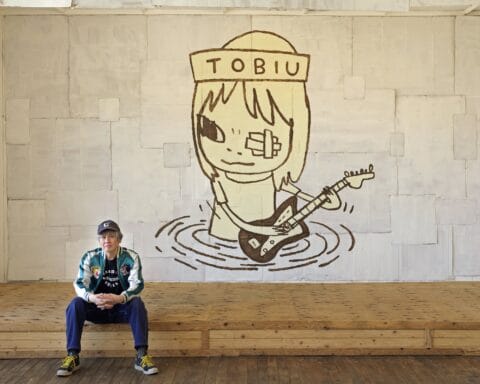In the realm of fashion, where grandiosity often finds favor, Hedi Slimane stands as a curious paradox. Known for his sharp lines, monochromatic palettes, and rebellious take on luxury, Slimane’s career has been nothing short of iconic. A visionary who reshaped modern menswear and defined the “skinny” silhouette, Slimane is more than just a designer; he is an artist who views fashion as a medium to express a cultural and intellectual narrative. From his influential work at Dior Homme to his provocative transformation of Yves Saint Laurent into Saint Laurent, and now, as the Creative Director of Celine, Slimane’s career is a testament to his talent for blending art, photography, and fashion.
Early Life and Influences: A Portrait in Black and White
Born in Paris in 1968, Slimane’s journey was atypical. The son of Tunisian and Italian parents, he grew up in a culturally rich environment that shaped his worldview. Initially drawn to art and architecture, he studied art history at the École du Louvre in Paris. The influence of architecture on his designs is unmistakable—his collections are clean, structural, and have a meticulous, almost mathematical precision.
Slimane’s early exposure to subcultures also profoundly impacted his aesthetics. Growing up during the punk and rock movements, he became enamored with the raw energy and individuality that these scenes embodied. This interest would later become central to his work, where a love for music and youth culture would merge seamlessly with fashion.

Dior Homme: Reinventing Masculinity
In 2000, Slimane took over as Creative Director for Dior Homme, where he would leave an indelible mark on men’s fashion. Slimane did more than just design clothes—he redefined what it meant to be masculine. Rejecting the bulky, oversized suits that had long dominated menswear, he introduced an almost subversive aesthetic of skinny silhouettes, narrow lapels, and sleek lines. His Dior Homme collections were unapologetically slender, understated, and monochromatic, reflecting a modern take on elegance that felt rebellious and refined in equal measure.
His slim, androgynous silhouettes spoke to a generation yearning for a break from traditional gender norms. This was fashion that pushed boundaries not through loud patterns or bold colors, but through the audacity of restraint. His influence quickly became cultural as well as sartorial; bands like The Strokes and Franz Ferdinand donned his designs, solidifying the “Slimane look” as the uniform of rock and roll for a new generation. Karl Lagerfeld famously lost over 90 pounds to fit into Slimane’s designs, further cementing the designer’s almost cult-like influence over style.

Photography and the Visual Archive of Youth Culture
One of the most unique aspects of Slimane’s career is his work in photography. Slimane sees fashion as only one of his artistic pursuits; photography, to him, is just as vital. Over the years, he has compiled a stunning body of photographic work, often documenting the same subcultures he draws inspiration from. His photos capture the spirit of youth and rebellion, documenting underground musicians, skaters, and artists with a keen eye for detail and authenticity.
In 2007, Slimane left Dior Homme to focus on his photography, a move that shocked the fashion world. During this period, he created “Hedi Slimane Diary,” an online archive showcasing his black-and-white portraits of cultural icons and unknown creatives alike. His photographic style—raw, intimate, and imbued with an almost documentary-like quality—revealed the same minimalist, rock-infused aesthetic he championed in fashion.

The Saint Laurent Transformation: Tradition Meets Transgression
Slimane’s return to fashion in 2012 as the Creative Director of Yves Saint Laurent, rebranded simply as Saint Laurent, marked the beginning of a new era for the storied French house. Slimane’s vision was a radical reinterpretation of Yves Saint Laurent’s legacy. He dropped “Yves” from the brand’s name and moved the headquarters to Los Angeles, a city he believed better reflected the edgy, youthful spirit he wanted to infuse into Saint Laurent. His designs at Saint Laurent were an homage to the subversive edge of youth culture, blending high fashion with a gritty, rock-and-roll ethos.
Slimane’s Saint Laurent collections polarized critics but captured the imagination of a generation. He reintroduced leather jackets, skinny jeans, and rock star-inspired looks into the luxury lexicon, drawing from the same punk and rock influences that had defined his early career. This period also saw Slimane cultivating a high-profile following among musicians like Courtney Love, Marilyn Manson, and Daft Punk. His Saint Laurent rebranding was audacious and transformative, blending tradition with transgression in a way that felt new, provocative, and timeless.
Yet Slimane’s stint at Saint Laurent was not without controversy. Critics accused him of sidelining Yves Saint Laurent’s legacy, and some saw his creative changes as too commercial, designed for mass appeal rather than avant-garde artistry. But Slimane’s vision ultimately proved prescient, making Saint Laurent one of the most profitable luxury brands of the 21st century.


Celine: A New Chapter and the Spirit of Innovation
In 2018, Slimane took over as Creative Director at Celine, another revered French house, and began a new chapter. His appointment marked a dramatic shift for Celine, a brand known for its minimalism under the direction of Phoebe Philo, who had cultivated a loyal following among women for her understated, sophisticated designs. Slimane’s arrival was a shock to Philo’s fans, as he immediately put his unmistakable stamp on the brand, reintroducing a rock aesthetic with shorter hemlines, sharper tailoring, and androgynous looks that appealed to a younger, more diverse audience.
With Celine, Slimane continued to explore his fascination with youth culture but expanded it to a more inclusive vision. He introduced men’s collections for the first time in Celine’s history, bringing his iconic skinny silhouette and monochromatic palette to a new audience. Slimane’s Celine continues his legacy of creating wearable art that blurs the lines between fashion, music, and subculture.

A Cultural Architect
Slimane’s influence on fashion is unparalleled. His designs are not merely clothes but symbols of a cultural movement—a blend of art, music, rebellion, and minimalism. Slimane is a designer who understands that fashion, at its best, is not just about aesthetics but about creating a narrative. He is a cultural architect, crafting a world where fashion and art coalesce, where youth culture becomes luxury, and where elegance is imbued with a touch of rebellion.
What makes Slimane unique is his intellectual approach to design. He has a rare ability to distill the spirit of a generation into clothing, to take elements from the underground and translate them into high fashion without losing their authenticity. His commitment to his aesthetic—one that values restraint, precision, and the ethos of rock and roll—has not only shaped his career but has redefined the way we think about luxury. Today, Hedi Slimane stands as one of fashion’s most influential figures, a designer who has carved out a legacy not through compromise, but through an uncompromising vision that has forever altered the landscape of modern style.






